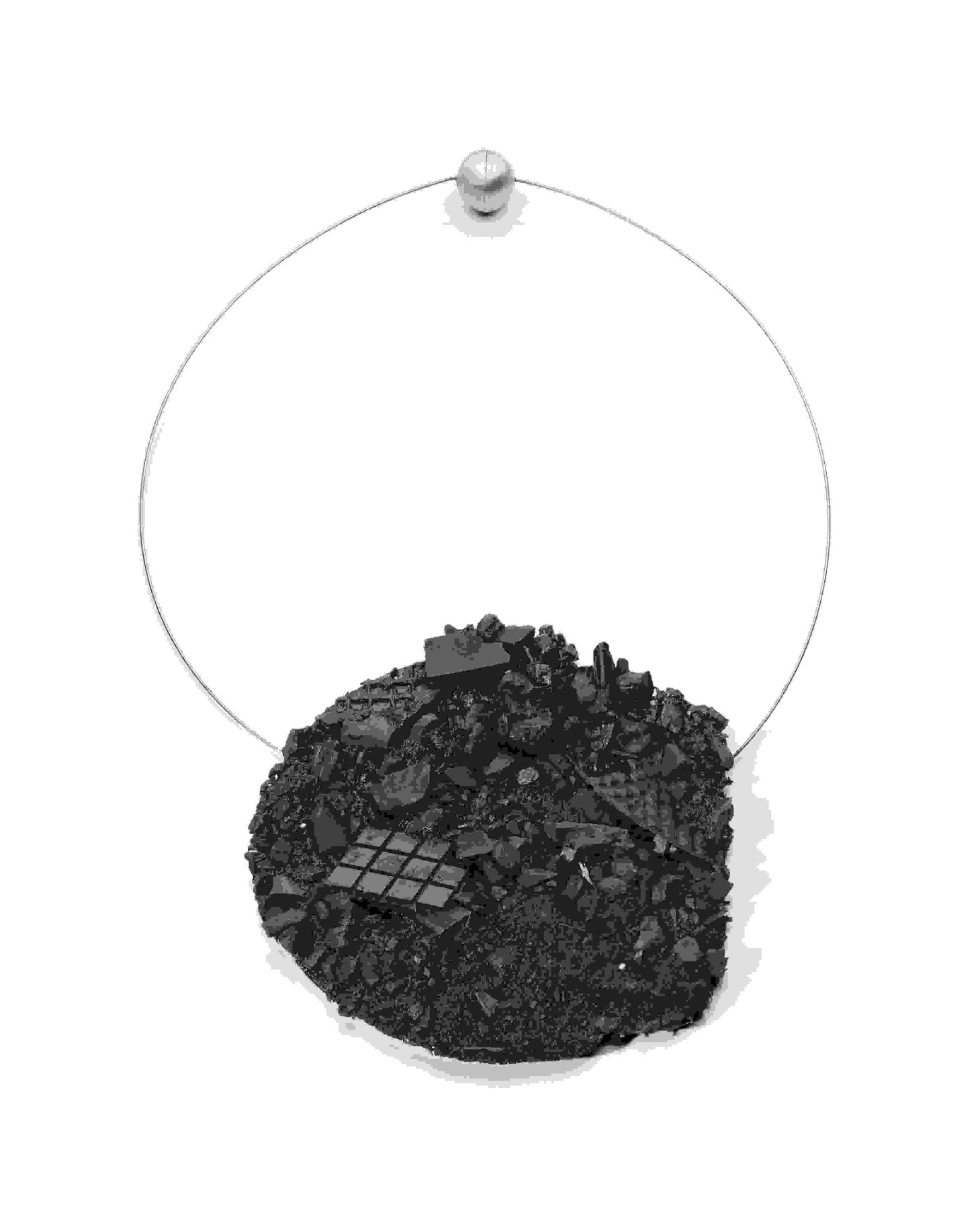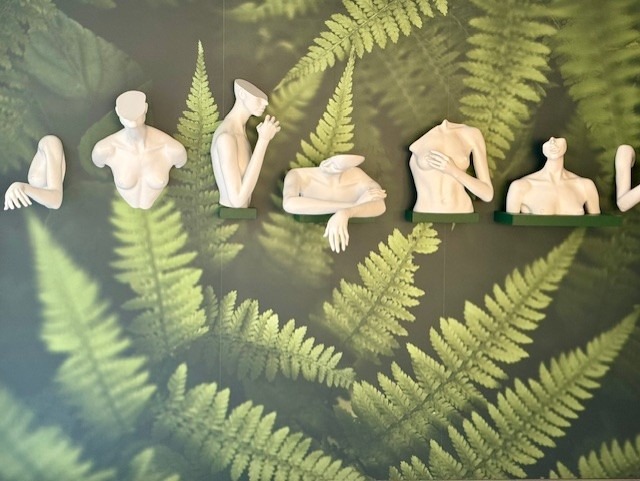
Nature and a Point of View
Is Anyone Here?, a jewellery exhibition at PUTTI Art Gallery / 16 May–15 June
On 16 May, the PUTTI Art Gallery has opened its final international exhibition. Titled Is Anyone Here?, the show features 40 artists who have been represented in both group and solo exhibitions over the gallery’s more than 20 years of existence. The exhibition will be accompanied by the release of the book Jewellery Is Not Just Jewellery, which summarises the history of the gallery and the contemporary and conceptual jewellery that it has featured over a period of 20 years.
The title of the exhibition is symbolic, as it embodies the ability to notice and comprehend what is so vividly captured in miniature form by contemporary jewellery – an art form that has always stood out for its ability to provoke and encourage the viewer/wearer to discover new perspectives on a seemingly familiar world, materials and forms. The title also alludes to a quite existential question: What is left when something is over? Moreover, is the end really “the end”, or is it part of a continuous process of transformation and creation?
To see better, sometimes you just have to look at something differently. And that is exactly what this exhibition offers – while symbolically bringing to the end one important stage, it takes us back to a relative beginning, a surreal space where the past is intertwined with the present and the future, and all possibilities/ideas are equally present. Some of them have already been captured – materialised in pieces of jewellery – while others still wander ethereally in an environment that resembles a visionary forest or meadow. They are here; you just have to be able to spot them.
The unifying elements of the exhibition are NATURE and one’s POINT OF VIEW. In fact, the exhibition is much like an observer’s meditative experience in which human and nature meet in relative silence and converse in the language of creativity... simply because it is the only one that can be understood without words. The exhibition is a story about receptiveness and the senses that we have either lost or that have been dulled down to almost nothing as a consequence of our alienation from nature, but which we must be able to recover in order to survive in this complex world. It is the story of the artist who still has this sensitivity, who notices/captures the marks left and discarded by nature and turns them into jewellery... who highlights the otherwise unnoticeable. The artist does this with their hands – through their touch, craftsmanship, and the use of natural materials and elements. The viewer/wearer sees the world magnified through these pieces of wearable art; moreover, when one looks upon them, they just might see themselves, as in a mirror. One sees what one needs at that moment to move on, be it beauty, challenge, perfection, chaos, thorns, threads, a moment of muffled silence amid all the noise…
Each of the 40 artists represented in the exhibition has their own point of view, and together they form a subtle web consisting of both visible and invisible worlds, as well as the often elusive (and perhaps only just perceptible) strings that connect the two.
Heng Lee. Necklace. "A Piece of Mountain – Heart of the Land IV", 2022
Hong Kong-based jewellery artist Heng Lee creates visually delicate, almost magical jewellery that resembles miniature forest fragments. It appears as if she’s zoomed-in on a specimen, then encapsulated it in brass, thereby capturing and encouraging us to notice movement and/or patterning which we might otherwise simply miss in the overwhelming number of shades of green we see in nature. In Lee’s jewellery, a fern becomes a work of art, a miniature object that unfurls its leaves within the wearer... and, perhaps, may even bloom at some point.
Lee reveals that her truest connection to nature occurred when she was an art teacher in Taiwan at the PADAN Asang School, a cultural experiment that is deeply entwined with the indigenous Bunun people.
Heng Lee. Brooch. "A Piece of Mountain – Davallia mariesii", 2021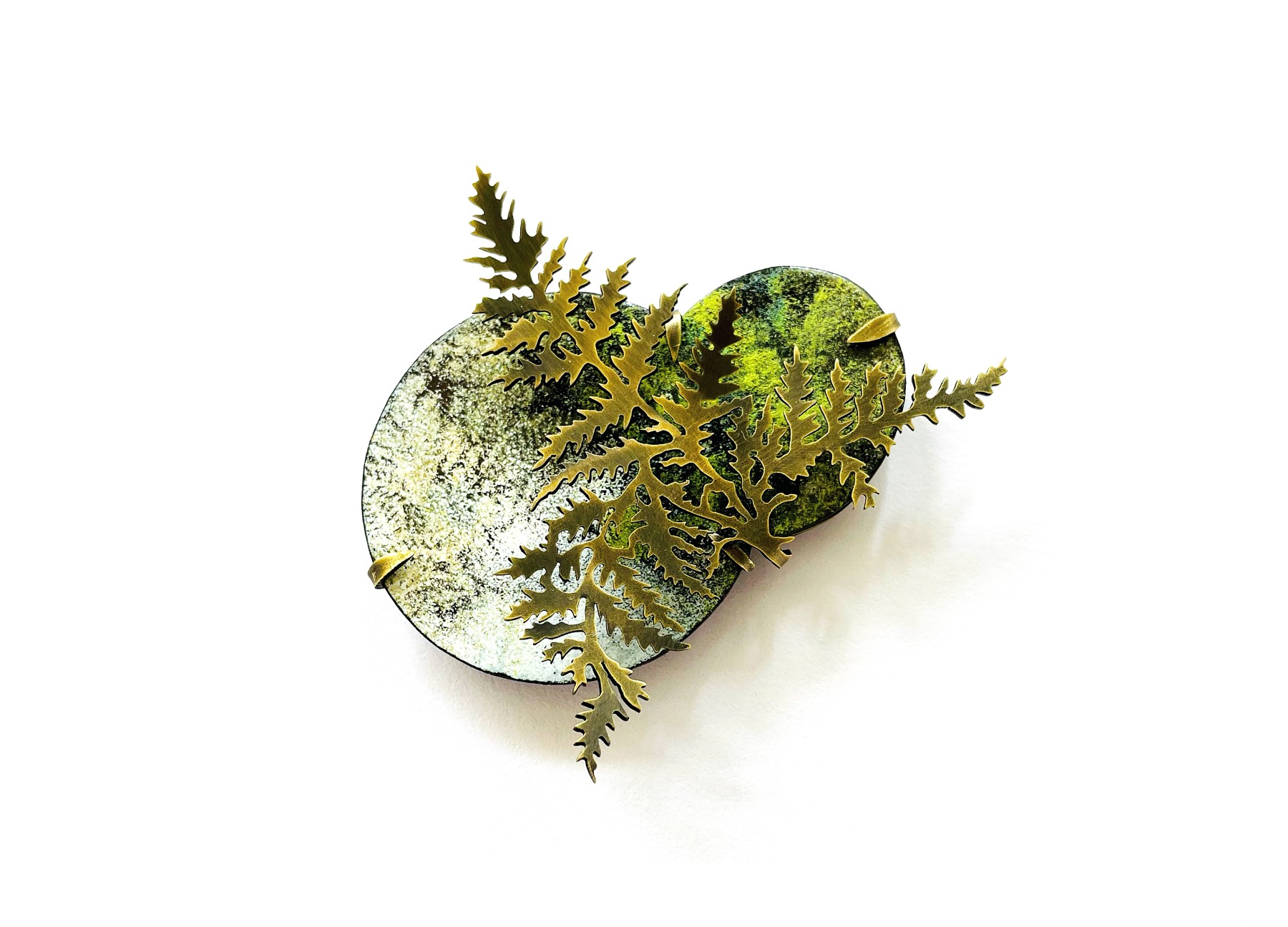
“I still remember the first time I followed the school team to the Mali mountains to study the migration paths of the Kaohsiung Bunun people and the old tribes. Walking along the mountain paths, I found that moss and lichen grow arbitrarily on stones and tree trunks, showing their vigorous vitality – perhaps in these places without human damage, they can coexist and prosper together. For the pieces in the jewellery series ‘A Piece of Mountain’, I created layers of fern from brass and used enamel to create the colours of the land,” writes Lee.
Marta Mattsson. Brooch. "Parrot"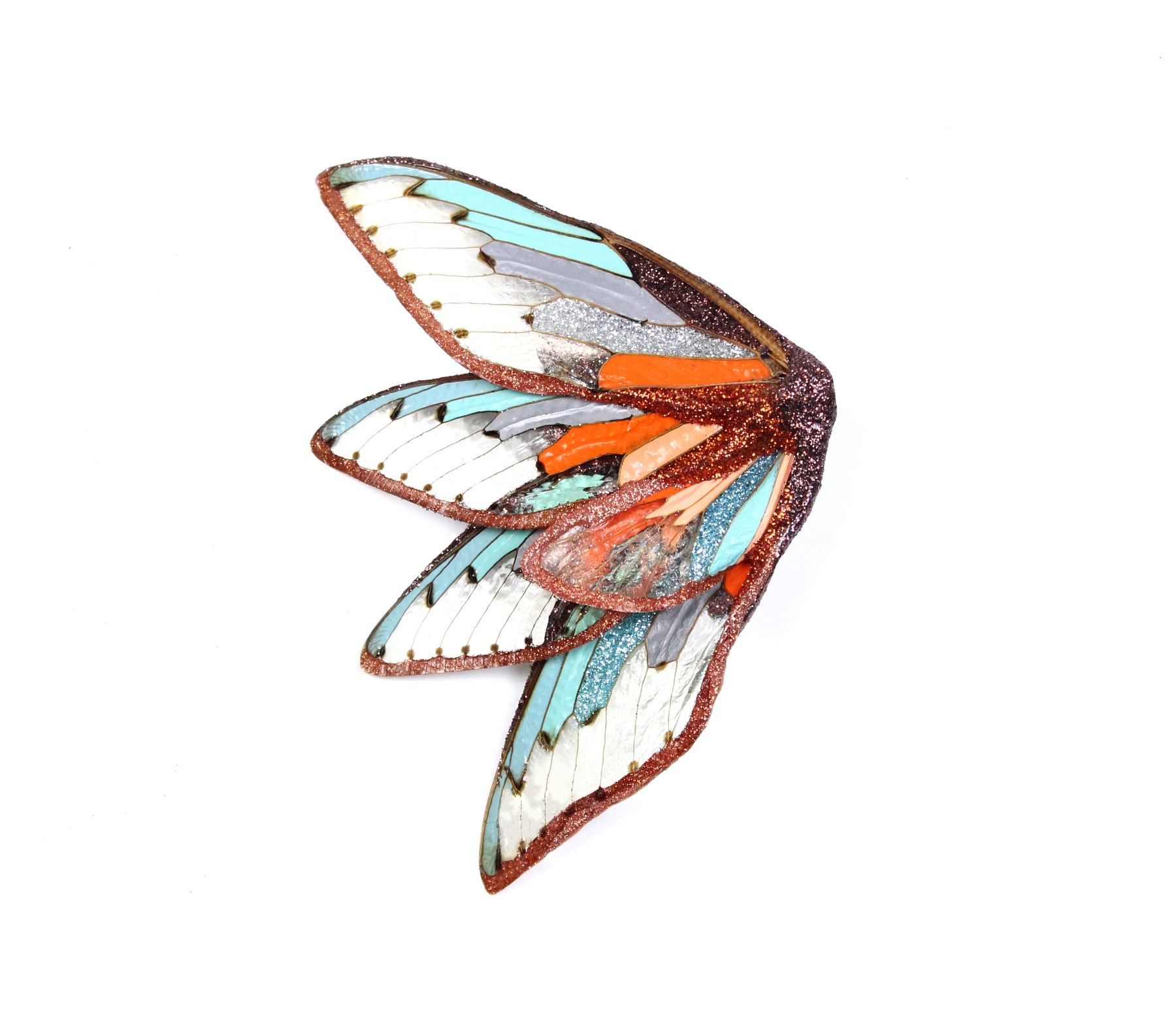
Swedish jewellery artist Marta Mattsson focuses on the emotional aspect of people’s relationship with nature. Often, during a few hours of a nature walk, it is possible to experience all the basic emotions – from joy to fear, disgust, surprise, and even sadness. Nature encourages us to let go, to be who we are in the moment, and at the same time, to observe how our moods and feelings change as we interact with nature. In nature, everything is in constant motion – something is born and something dies. Some win and some lose, some flourish and some wither, but at the same time, there is an incredible harmony... because in nature, everything is exactly as it should be.
Mattsson’s jewellery is also a part of nature – she works with insects, animal remains and other bio-matter; she also uses spiders a lot because they bring good luck. Her jewellery seems to continue the infinite cyclicality of nature in which life is replaced by death, which again becomes the source of new life. In Mattsson’s jewellery, the transience of the life of the butterfly takes on a poetic timelessness.
“In the intricate tapestry of human existence, the relationship between humanity and nature is a multifaceted one defined by a myriad of emotions, experiences, and perceptions. Like most people, I find myself drawn to the natural world, captivated by its ineffable beauty and boundless complexity; yet certain parts of nature and its forces also scare and intimidate me. In my art and in my personal voyage of trying to understand what it means to be human, I seek to capture the essence of this complex relationship – to distill the paradoxical interplay of awe and apprehension. Each piece is created with a play between attraction and repulsion, and contains a tension between fear and fascination of the natural world and its creatures,” states Mattsson.
Sara Barbanti. Necklace. "Collage", 2020. Photo: Paolo Terzi
Aesthetic existentialism is also a hallmark of the jewellery of Italian artist Sara Barbanti – she makes her pieces from charcoal extracted from the wood of dead trees in her family’s orchard. “It’s fundamental to me to give importance to a crude material, to transform a scrap into something precious and to extend the life cycle of this natural element,” says Barbanti. Her jewellery highlights the texture of a seemingly lost time, allowing the imagination to wander through fragments of each individual’s own memories. Charcoal, which was once a tree and then, eventually, fire, holds the secret of transformation – the ruins of ancient civilisations, or perhaps the childhood memory of finding mom’s secret chocolate stash... it all depends on what we are ready to see at that moment – both in ourselves and around us.
Valdis Brože. Brooch. From the series "Timeless"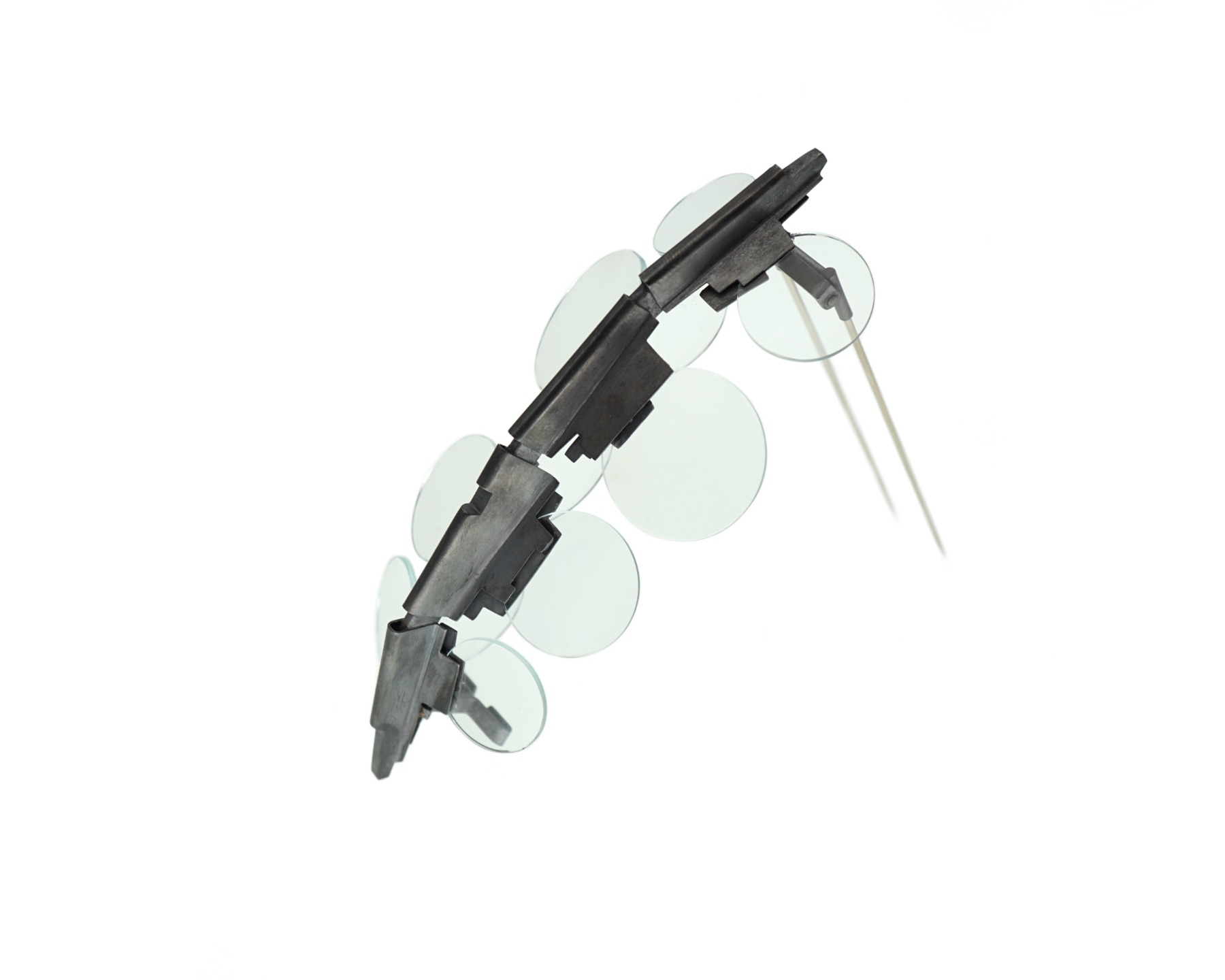
In his jewellery series “Timeless”, Latvian artist Valdis Brože explores the relativity of time and its illusory nature. The sense of time and its passage can seemingly completely change depending on whether you are in a natural environment or in the city. A rushed gaze can simply drift – like the landscape passing by the window of a moving car; whereas if you stop, you’ll notice meadows with dandelions bursting into spring bloom and the filigree flouring mounds of bird cherry trees. Brože’s jewellery is made of watch crystals and black or gold elements. The pieces are laconic but also saturated – like the infinite possibilities offered by each individual moment. “There are no dials or hands – there is time and space, which are important to us,” writes Brože, encouraging us to appreciate the rhythms and shapes that surround us in our daily lives – the harmoniousness of its flow or, on the contrary, its chaos... to find and capture our own rhythm and try not to “fall out” of it, while noticing how different it is from the one we often live in on a daily basis.
Eero Hintsanen. Bracelet. "Drop Dead Gorgeous". 2023. Photo: Chao-Hsien Kuo
The relationship between time and place is also the focus of Finnish artist Eero Hinsanen’s work. His pieces are inspired by the rural landscape of eastern Finland, where he grew up. Memories, although seemingly rooted in a specific place and time, change and transform over the years. Reality mixes with imagination and, like stories retold from one generation to the next, they “grow” thicker with detail, sometimes – to effect, sometimes – not quite. And, depending on one’s point of view, they can also change roles.
“In every curve and contour, my jewellery encapsulates the essence of a time and place, challenging viewers to delve into layers of their own memories. The combination of animal- and plant-like shapes creates objects that appear to be plucked from nature rather than meticulously crafted by human hands. I aspire to create jewellery that transcends its ornamental function and can be appreciated as a miniature sculpture that fosters a deeper connection between the wearer and art,” writes Hintsanen.
Annette Dam. Necklace. OUTGROWING #1, 2022. Photo: Dorte Krogh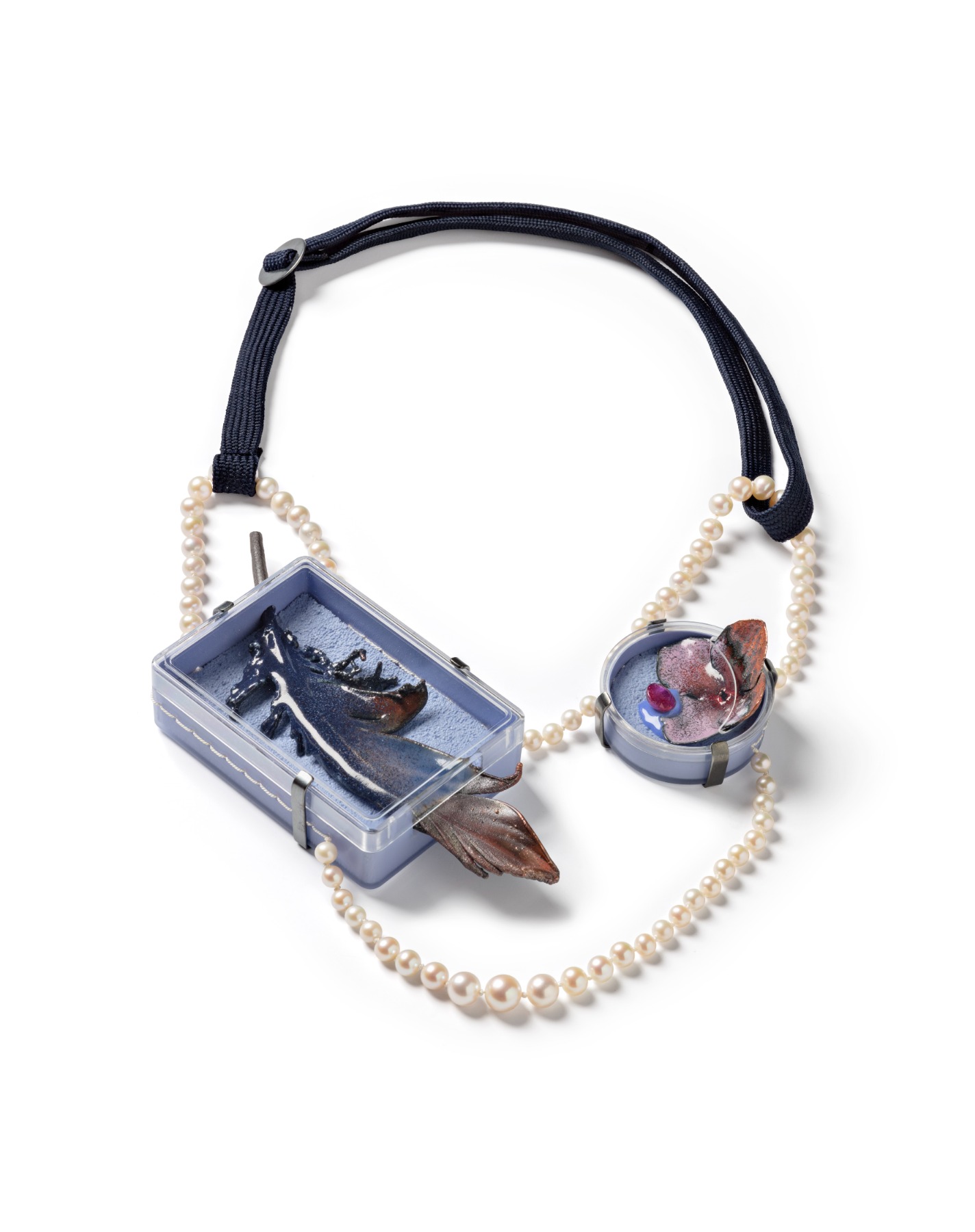
Meanwhile, Norwegian jewellery artist Annette Dam focuses on movement and the absurd human desire to constantly categorise and put things into “boxes” in an attempt to mimic the belief that one has understood something. Her jewellery is an ode to the Socratic “I know that I know nothing”, encouraging us to remain open to a process in which nothing, and no specific knowledge, is ever exhaustive. “Contemporary artists are also often in a state of process, growth and movement, using their creative skills to reflect and potentially express a critical angle on their surroundings. I find it interesting and inspiring to see jewellery artists materialise their voices, thereby adding their narrative to the tale of our times,” says Dam. The stylised elements of nature – a leaf and a flower – in her necklace have ironically grown out of/outgrown the box in which someone has tried to put them. They obviously don’t fit – just like the many stereotypes, supposed taboos, or so-called self-evident truths of contemporary society.
Barbara Uderzo. Ring. "Wildvegetation", 2024. Photo: Andrea Ferrero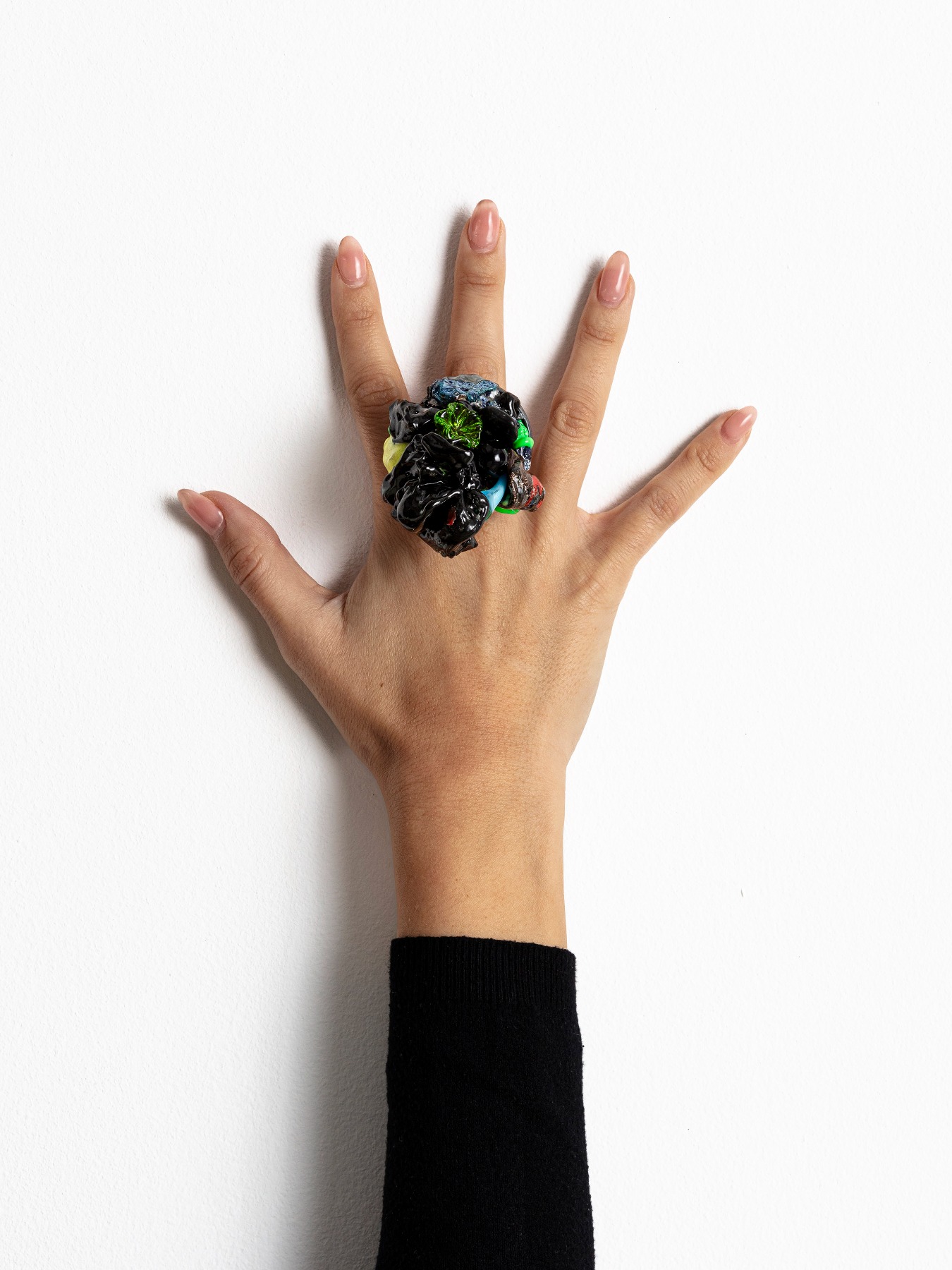
In the jewellery of Italian artist Barbara Uderzo, the natural, the untamed and the wild fuse with the artificial. They are like two coexisting opposites constantly challenging each other. The lava that flows from a volcano destroys everything in its path, yet it also creates new forms. It is impossible to try to stop it or stand in its way, much like trying to change the bed of a river. Nature is the best teacher of humility, and if its lessons are long ignored, it can become downright radical. On her work, Uderzo writes: “The nature that materialises in my jewellery is an unspoilt and wild nature that grows and evolves autonomously, free and independent of any human will. It is lush, growing on itself to form an intricate and wonderful fabric. It is a nature of lights, colours and shadows... dark and opaque areas, others transparent or frothy... and more vibrant zones.” Uderzo’s jewellery is a stylised and impenetrable landscape where no one has set foot... a jungle of the subconscious mind that is both terrifying and seductive. Nevertheless, it can become a worthy companion for the journey.
Guntis Lauders. "Lizards and Wizards"
Latvian jewellery artist Guntis Lauders also makes no secret of the fact that nature is one of his greatest teachers. “Nature is my inspiration and one of my greatest teachers. In order to create something, I need to be in the silence of nature from time to time. Being there allows me to access thoughts and feelings that are deep inside me; and the more I look, the more I see… Symbols, metaphors and images just appear in front of my eyes – all I have to do is take note of them and turn them into jewellery. I feel that many people have lost their connection with the natural world. I invite them to return to their roots through my jewellery.”
Unlike with other art forms, in the field of contemporary jewellery, the echo of the world’s current affairs and the narrative of its events are much more subdued and seemingly invisible. Works of contemporary jewellery are more like small allegorical poems that speak to the senses in the language of material and form. Like nature, they directly train one’s sensitivity – to see, to notice, to think. To look at a drop of water, a grain of sand, the veining of a tree leaf, or a miniature fragment of the world through a kind of magnifying glass, thereby glimpsing the otherwise unnoticeable. Almost anything can become its source material; in this sense, contemporary jewellery has no limits.
Nicolas Estrada. Bracelet. "Balsillas", 2019. Photo: Joan Soto
The themes that I draw inspiration from are directly connected to the humanity and sensitivity of those who observe my artwork. My pieces do not aim to defend or take a stance on issues that are undoubtedly central and significant in my country and continent. Instead, they represent the pure and unfiltered vision of an artist who strives to offer fresh perspectives using the tools provided by my artistic practice. Each piece of jewellery holds great power and worth in my eyes. Encapsulated within my work, it is a poetic gesture that emerges through the interpretation of my profound and meaningful artistic reflections. These reflections are conveyed through an intimate dialogue between the object and the viewer’s gaze. – Nicolas Estrada
Ariel Lavian. Necklace. "Scorched Earth", 2023
The poetry and miniature form of contemporary jewellery is vividly embodied in Israeli artist Ariel Lavian’s very personal work titled “Scorched Earth” – birds’ nests containing crushed eggshells from which chicks will never hatch.
“I live on one of the mountains surrounding Jerusalem. Until recently, the view from my window was the forest full of trees and life. But now, after the fires, all that is left is scorched earth; all the forests in the mountains around me have burned; everything is black, sooty, lifeless, dead.
Nature has not yet recovered...
Neither have I…,” writes Lavian.
Sometimes it’s just one step from a thriving, flourishing and fully functioning world to one that is nothing but rubble. Just one single foolish act. This applies to everything – both human relationships (individuals, communities, countries) and our relationships with nature, of which we are a part. By upsetting the balance in nature, we upset the balance in ourselves. By distancing ourselves from nature, we draw away from ourselves. By destroying nature, we destroy ourselves. By listening to nature, we listen to ourselves. By looking into nature, we see ourselves. By conversing with nature, we converse with ourselves. By taking care of nature, we take care of ourselves. When we shout at nature, we shout at ourselves. By belittling nature, we belittle ourselves. By loving nature, we love ourselves. It is precisely so simple, and yet so complex.
Marie-Louise Kristensen. Brooch. "Conductor", 2021. Photo: Dorte Krogh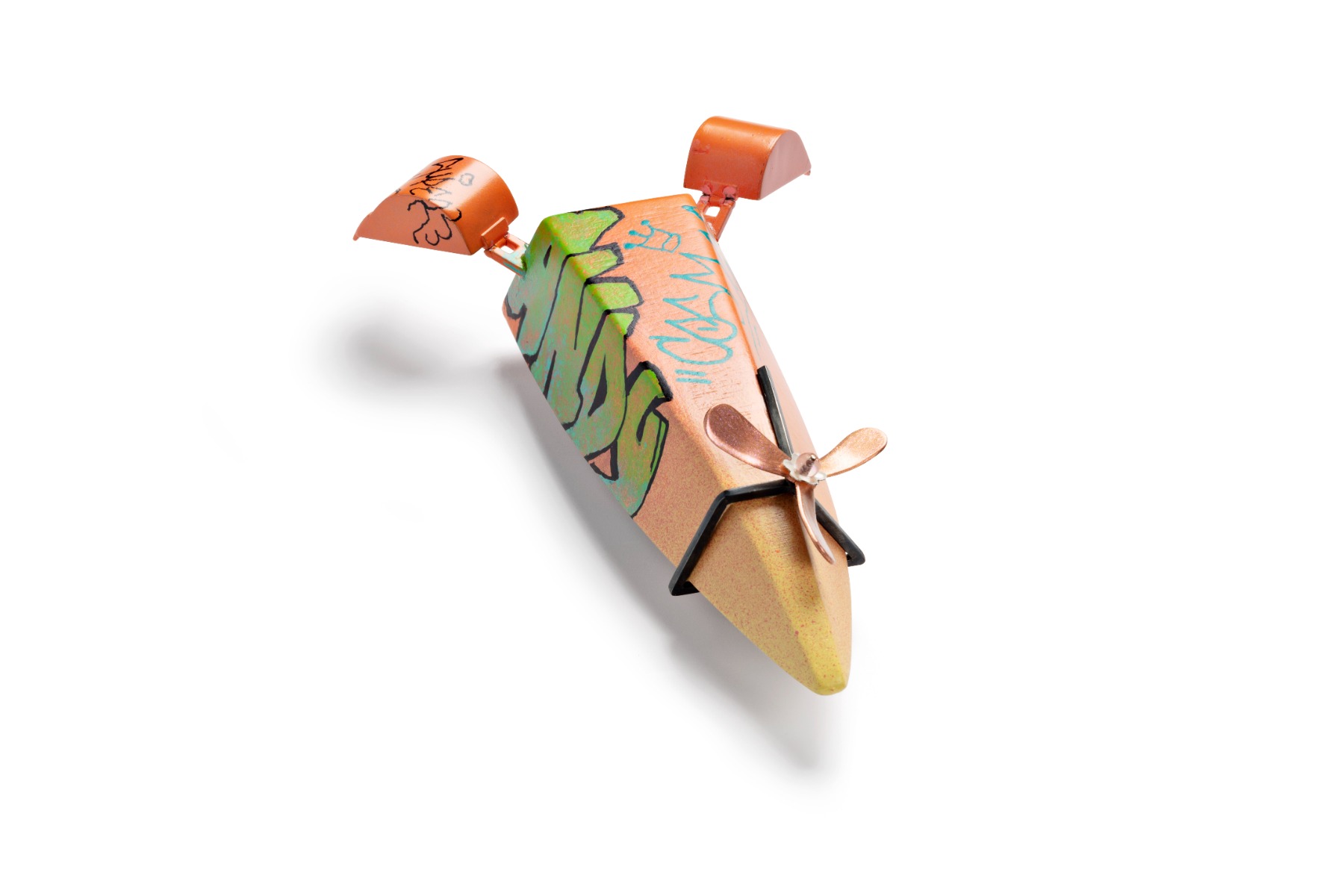
Danish artist Marie-Louise Kristensen writes: “I believe we humans need to recognise and care for all kinds – big and small, known and unknown…”
Otherwise, the question Is Anyone Here? may not be answered. Because there will be no one to answer and no one to hear the answer. And no one to ask the question.
Is Anyone Here? is actually a very crucial question because it teaches gratitude, humility and responsibility, all at the same time... towards those with whom we are together.
